- About MAA
- Membership
- MAA Publications
- Periodicals
- Blogs
- MAA Book Series
- MAA Press (an imprint of the AMS)
- MAA Notes
- MAA Reviews
- Mathematical Communication
- Information for Libraries
- Author Resources
- Advertise with MAA
- Meetings
- Competitions
- Programs
- Communities
- MAA Sections
- SIGMAA
- MAA Connect
- Students
- MAA Awards
- Awards Booklets
- Writing Awards
- Teaching Awards
- Service Awards
- Research Awards
- Lecture Awards
- Putnam Competition Individual and Team Winners
- D. E. Shaw Group AMC 8 Awards & Certificates
- Maryam Mirzakhani AMC 10 A Awards & Certificates
- Two Sigma AMC 10 B Awards & Certificates
- Jane Street AMC 12 A Awards & Certificates
- Akamai AMC 12 B Awards & Certificates
- High School Teachers
- News
You are here
Probability-2

Publisher:
Springer
Publication Date:
2019
Number of Pages:
348
Format:
Hardcover
Price:
79.99
ISBN:
978-0-387-72207-8
Category:
Textbook
[Reviewed by , on ]
Allen Stenger
10/26/2019
See our review of the first volume, Probability-1. This second volume continues the first volume but has a different focus. The first volume was about probability in general, while the second volume deals with random processes and in particular with sequences of random variables. These two volumes are a translation of the two volumes of the Russian fourth edition, that appeared in 2007.
The second volume is much more oriented to applications than the first. It covers (for example) normal numbers (in number theory), Monte Carlo integration, renewal theory, optimal filtering and control (including the Kalman–Bucy filter), a number of inequalities proved by martingale theory with some applications, financial applications including hedging and options, and stopping rules (two approaches: martingales and Markov processes). Most of these topics are sketched; there is enough detail to understand how probability is used, but not enough to apply it in practice.
The bulk of the book deals with martingales and with Markov processes and their applications. These start from the beginning, have very thorough coverage and often digress into useful applications. The book starts with an introductory chapter on general facts about sequences of random variables. It includes some very interesting results on zero-one laws, that is, theorems that a certain probability is either zero or one. There are two chapters on stationary sequences: a very brief one for stationary in the strict sense (including some ergodic theory) and a longer one for stationary in the wide sense, including analysis of their behaviors and applications. The book concludes with a separate historical essay, “Development of Mathematical Theory of Probability: Historical Review” that the author wrote for the third (Russian) edition of Kolmogorov’s Foundations of the Theory of Probability in 1998.
I found this second volume to be much more interesting than the first volume. Happily, it does not have a strong dependence on the first volume (there are only a few explicit references), so I think this would be an excellent text by itself for an advanced course in probability. Shiryaev’s book Problems in Probability contains problems for both volumes and is a useful supplement.
Allen Stenger is a math hobbyist and retired software developer. He is an editor of the Missouri Journal of Mathematical Sciences. His personal web page is allenstenger.com. His mathematical interests are number theory and classical analysis.
See the publisher's web page.
- Log in to post comments




